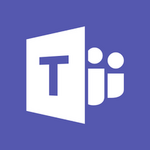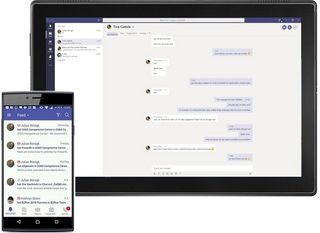
Microsoft Teams is a chat-based central workspace (hub). Its purpose is the digital support for more effective communication and collaboration in teamwork. The service is based on existing Microsoft technologies and can integrate other Microsoft 365 services.
However, Microsoft Teams is more than just a chat solution. In addition to functions for chat, phone calls and meetings, the service provides access to many other Microsoft 365 services, such as SharePoint Online, Skype for Business, Office Groups, OneDrive and even Planner.

Teams is Microsoft’s implementation of the “Intelligent Communication” vision. The tool has won the Best of Enterprise Connect Award, leaving 40 other top manufacturers behind.
> More about the Microsoft Teams Award
As a central work space for teamwork, Microsoft Teams is intended for businesses of all sizes – from major enterprises to small and medium-sized companies. It is ideal for:
With Microsoft Teams, you will have a central place in which you can work together with your team. Expand the functionality of this service by integrating connectors and apps from Microsoft 365 or other third-party tools.
Bots are automated programs that answer questions and send notifications. For example, you can use the T-Bot to learn more about Microsoft Teams or PMOtto as a personal project management assistant. Integrate additional bots from the Microsoft Store.

Microsoft Teams is available on different devices: online, as a desktop client or as a mobile application – regardless of whether you are using an iOS device or an Android phone or tablet.
In addition, if you create a team, you automatically create a channel. Additional channels can be added manually by the user.
Channels are individual sections within a team. Within them, conversations are organized according to specific topics, projects, disciplines or other important aspects. All team members can have open conversations in team channels. These are visible for everyone.
The functionalities of the channels can be increased using connectors and apps. Connectors are interfaces with other services within or outside the Microsoft Cloud.
Outlook: Outlook is used for traditional 1:n communication. Information is sent to one or more recipients by email. There is neither a common file repository, nor can documents be edited together as a team. Unlike the chat-based solutions Teams or Skype, it delays the exchange of information.
Yammer: Yammer is the social network for businesses. It is therefore aimed at a large group of participants. As in Facebook, you can upload posts. Hence, Yammer is more of a company-wide “news hub” available to all employees. It is intended to strengthen activities in the context of corporate culture.
Teams: As a hub for teamwork, Microsoft Teams especially supports the cooperation and communication within small and large groups or departments. This service is aimed at employees who want to collaborate and communicate with each other in a narrower circle. All shared information is always available to all team members and can be centrally edited and commented on.
Skype: Both Skype and Teams are chat-based solutions and enable the exchange of information. The difference lies in the way central information is shared and edited and the people who can access it. Teams has solved this better than Skype. Hence, Teams has replaced Skype as Microsoft’s professional online meeting solution.

Would you like a free personal online consultation with a TPG expert to find out how you can take your multi-project / program management to the next level? Together we will talk about your questions, requirements and possible next steps – no costs for you!
Please click on the "Contact us now" button below and the contact form will open. Submit the form and we will get back to you as soon as possible with a proposed date for your free online consultation.